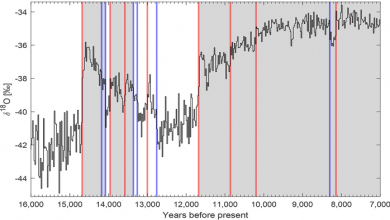Geophysical consequences of celestial mechanics

by Vincent Courtillot, Jean-Louis Le Mouel and Fernando Lopes
Sources of variability of some terrestrial and solar phenomena.
As former members of the geomagnetism department at IPGP (Institut de Physique du Globe de Paris), we have always retained an interest in solar-terrestrial relationships. Being in charge of geophysical observatories, we have always paid the foremost attention to long series of observations and as a consequence to methods of time series analysis. As of some five years ago, we have undertaken a systematic study of several long series of observations recorded around the globe (“long” means from several decades up to three centuries).
The research program has been quite productive, with the publication of some 24 articles in the past five years (all freely available online; references at the end of this note). The papers have been published in a very diverse set of journals, mostly in geophysics and astrophysics (in a broad sense). Because we came from the solid Earth geophysics community, it was not always easy at first to be recognized. Thus, we published in those journals where our French IPCC colleagues published, such as Cryosphere or Earth and Planetary Science Letters, MDPI or Frontiers. As a result, readers may have found it uneasy to grasp the wider picture. This short note is intended to try and draw this wider picture, to stress some of its consequences in the spirit of the paper’s title, and to give full references to the papers published in the frame of the program.
We have first determined the spectral content of many long series of observations, using either the Wavelet Method (WM) or Singular Spectrum Analysis (SSA). These series include global mean temperature and pressure of the lower atmosphere, a number of climate-related indices, solar activity through sunspots, length of the day, geomagnetic indices, extent of high latitude sea-ice, and more…
SSA allows one to decompose (in a way that a posteriori makes sense) a time series into a smooth trend and a series of components characterized by specific periodicities or pseudo-periods, based on which the series can be filtered and reconstructed.
We first applied the method to the series of sunspot numbers. The series could be satisfactorily reconstructed from simply a (rather flat) trend and two components with periods 11 years (Schwabe cycle) and 90 years (Gleissberg cycle). More interestingly, these components allow one to construct a precise and robust model of solar activity and to predict (so far rather accurately) the ongoing sunspot cycle and beyond [ref 1, 2, 3].
We have next determined the SSA components of the length of day (or Earth’s rotation velocity) and motions of our planet’s pole of rotation. To the Schwabe and Gleissberg cycles could thus be added the Hale (~22 years) and Jose (~160 years) cycles [ref 4, 5, 6]. We also analyzed tide gauges and sea-level change [ref 7, 8]. In all these series we could recognize the signatures of the four Jovian planets (Jupiter, Saturn, Uranus and Neptune): i.e. their periods of rotation and many of their “commensurable” periods. This argues for a mechanism involving exchanges of angular momentum between the Sun, Earth and planets. Variations in the inclination of the rotation axis due to this coupling in turn affect insolation, much in the way exemplified by Milankovic cycles at much longer periods (from tens of thousands to millions of years). We propose to extend the concept of Milankovic cycles to the much shorter periods we have analyzed [ref 9, 10].
The main components mentioned above are common (in whole or in part) to all the series we have analyzed [ref 11, 12, 13, 14, 15, 16, 17, 18, 19, 20, 21, 22, 23, 24]. The fact that these series of components are found in the rotational mechanics of the planets and in many Earth-bound phenomena argues for a causal (forcing) relationship that can only work one way. The components one finds in sea level, pressure, temperature… must arise from a causal chain going (1) from Jovian planets to the Sun
(or directly to Earth), then (2) to inclination changes in Earth’s rotation axis, with (3) consequences on insolation changes (therefore climate), sea level and tides [ref 8, 10, 17].
We note that trends could actually correspond to still other pseudo-periodic components with much longer pseudo-periods (longer than the data interval). As a result, we argue that a very large part of the geophysical and atmospheric variations covered by the series we have analyzed appear to have an external origin (astronomical or gravitational). The perturbing effects of the giant planets correspond to a remarkable set of frequencies [ref 5, 19] that modulate (force) solar activity, variations in inclination of the Earth’s rotation, many terrestrial parameters among which sea level, oceanographic indices, sea – ice and finally temperature. These components have in general not yet been modeled.These works shed light and are in turn illuminated by the works of giants, the Legendre, Laplace, Lagrange and Poisson, who revolutionized geophysics [ref 25, 26, 27, 28]. The core of their elegant physics explains well the careful observations gathered in the past 200 years.
The first results of our research program have been discussed in an informal seminar at the Paris Academy of Sciences last May. Some 20 academy members attended and a lively open discussion followed. We hope this open, truly scientific attitude prevails.
About the authors. Vincent Courtillot ([email protected]) and Jean-Louis Le Mouël are both emeriti professors of Geophysics at University of Paris, members of the Paris Academy of Sciences and former directors of Institut de Physique du Globe de Paris. Fernand Lopes ([email protected]), also formerly at IPGP, now at Museum National d’Histoire Naturelle, is a Research Engineer with a PhD in geophysics and a specialty in computing, inverse problems and time series analysis.
JC note: This is an important body of work, addressing many “known unknowns” in the climate system. I encourage you to pick a paper, read it, and comment on it.
Papers published in the frame of this research :
• [ref 1] Le Mouël, J. L., Lopes, F., Courtillot, V. (2017). Identification of Gleissberg cycles and a rising trend in a 315-year-long series of sunspot numbers. Solar Physics, 292(3), 43.
• [ref 2] Le Mouël, J. L., Lopes, F., Courtillot, V. (2020). Solar turbulence from sunspot records. Monthly Notices of the Royal Astronomical Society, 492(1), 1416-1420.
• [ref 3] Courtillot, V., Lopes, F., Le Mouël, J. L. (2021). On the prediction of solar cycles. Solar Physics, 296, 1-23.
• [ref 4] Le Mouël, J. L., Lopes, F., Courtillot, V., Gibert, D. (2019). On forcings of length of day changes: From 9-day to 18.6-year oscillations. Physics of the Earth and Planetary Interiors, 292, 1-11.
• [ref 5] Lopes, F., Le Mouël, J. L., Courtillot, V., Gibert, D. (2021). On the shoulders of Laplace. Physics of the Earth and Planetary Interiors, 316, 106693.
• [ref 6] Lopes, F., Courtillot, V., Gibert, D., Mouël, J. L. L. (2022). On two formulations of polar motion and identification of its sources. Geosciences, 12(11), 398.
• [ref 7] Le Mouël, J. L., Lopes, F., Courtillot, V. (2021). Sea-Level Change at the Brest (France) Tide Gauge and the Markowitz Component of Earth’s Rotation. Journal of Coastal Research, 37(4), 683-690.
• [ref 8] Courtillot, V., Le Mouël, J. L., Lopes, F., Gibert, D. (2022). On sea-level change in coastal areas. Journal of Marine Science and Engineering, 10(12), 1871.
• [ref 9] Lopes, F., Courtillot, V., Gibert, D., Le Mouël, J. L. (2022). Extending the range of milankovic cycles and resulting global temperature variations to shorter periods (1–100 year range). Geosciences, 12(12), 448.
• [ref 10] Courtillot, V., Lopes, F., Gibert, D., Boulé, J. B., Le Mouël, J. L. (2023). On variations of global mean surface temperature: When Laplace meets Milankovi\’c. arXiv preprint arXiv:2306.03442. (in sub)
• [ref 11] Courtillot, V., Le Mouël, J. L., Kossobokov, V., Gibert, D., Lopes, F. (2013). Multi- decadal trends of global surface temperature: A broken line with alternating~ 30 yr linear segments?. Atmospheric and Climate Sciences, 3, 364-371.
• [ref 12] Le Mouël, J. L., Lopes, F., Courtillot, V. (2019). A solar signature in many climate indices. Journal of Geophysical Research: Atmospheres, 124(5), 2600-2619.
• [ref 13] Le Mouël, J. L., Lopes, F., Courtillot, V. (2019). Singular spectral analysis of the aa and Dst geomagnetic indices. Journal of Geophysical Research: Space Physics, 124(8), 6403-6417.
• [ref 14] Le Mouël, J. L., Lopes, F., & Courtillot, V. (2020). Characteristic time scales of decadal to centennial changes in global surface temperatures over the past 150 years. Earth and Space Science, 7(4), e2019EA000671.
• [ref 15] Dumont, S., Le Mouël, J. L., Courtillot, V., Lopes, F., Sigmundsson, F., Coppola, D., … Bean, C. J. (2020). The dynamics of a long-lasting effusive eruption modulated by Earth tides. Earth and Planetary Science Letters, 536, 116145.
• [ref 16] Le Mouël, J. L., Lopes, F., Courtillot, V. (2021). A strong link between variations in sea-ice extent and global atmospheric pressure?. The Cryosphere Discussions, 1-28.
• [ref 17] Lopes, F., Zuddas, P., Courtillot, V., Le Mouël, J. L., Boulé, J. B., Maineult, A., Gèze, M. (2021). Milankovic Pseudo-cycles Recorded in Sediments and Ice Cores Extracted by Singular Spectrum Analysis. Climate of the Past Discussions, 1-17.
• [ref 18] Lopes, F., Courtillot, V., & Le Mouël, J. L. (2022). Triskeles and Symmetries of Mean Global Sea-Level Pressure. Atmosphere, 13(9), 1354.
• [ref 19] Lopes, F., Courtillot, V., Gibert, D., Le Mouël, J. L., Boulé, J.B (2022). On pseudo- periodic perturbations of planetary orbits, and oscillations of Earth’s rotation and revolution: Lagrange’s formulation. arXiv preprint arXiv:2209.07213.
• [ref 20] Courtillot, V., Le Mouël, J. L., Lopes, F., Gibert, D. (2022). On the nature and origin of atmospheric annual and semi-annual oscillations. Atmosphere, 13(11), 1907.
• [ref 21] Lopes, F., Courtillot, V., Gibert, D., Mouël, J. L. L. (2023). On the annual and semi-annual components of variations in extent of Arctic and Antarctic sea-ice. Geosciences, 13(1), 21.
• [ref 22] Le Mouël, J. L., Gibert, D., Courtillot, V., Dumont, S., Ars, J., Petrosino, S., … Geze, M. (2023). On the external forcing of global eruptive activity in the past 300 years. arXiv preprint arXiv:2304.09564. (just accepted in Frontiers in Geosciences)
• [ref 23] Courtillot, V., Boulé, J. B., Le Mouël, J. L., Gibert, D., Zuddas, P., Maineult, A., … & Lopes, F. (2023). A living forest of Tibetan Juniper trees as a new kind of astronomical and geophysical observatory. arXiv e-prints, arXiv-2306. (in sub)
• [ref 24] Le Mouël, J. L., Lopes, F., Courtillot, V., Gibert, D., & Boulé, J. B. (2023). Is the earth’s magnetic field a constant? a legacy of Poisson. Geosciences, 13(7), 202.




